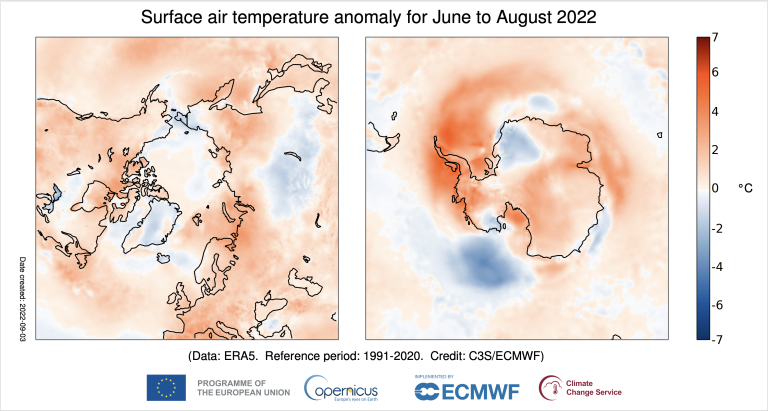Europe has hottest summer on record: EU Copernicus

Europe just had its hottest summer and hottest August on record, according to the EU’s Copernicus Climate Change Service (C3S), implemented by the European Centre for Medium-Range Weather Forecasts. ECMWF datasets feed into WMO’s State of the Climate reports.
The August temperature was 0.8°C above August 2018, and summer was 0.4°C warmer than June-August 2021. In addition to heatwaves in Europe, there were also heatwaves over central and eastern China for all three summer months. France had its second warmest summer on record (after 2003). England had its joint hottest summer, on a par with 2018, in terms of mean temperature.
Devastating wildfires across Europe this summer caused the highest emissions since 2007, according to Copernicus Atmosphere Monitoring Service. The combination of August’s heatwave with prolonged dry conditions across western Europe resulted in increased wildfire activity, intensity and persistence.
Globally it was the joint third warmest August on record (similar to the values for August 2017 and 2021 and within about 0.1°C of the higher values reached in August 2016 and 2019), according to Copernicus Climate Change Service.
A large part of China experienced temperatures that were much higher than average. Heatwave conditions were especially severe in the drought-affected Sichuan Basin. Western regions of Canada and the USA also experienced unusually high temperatures. Antarctica saw regions of markedly above and below average temperature interspersed over and around the continent, as is often the case.
Flood-hit Pakistan continued to have below-average temperatures, in stark contrast to the unusually hot conditions it experienced in the pre-monsoon period. To the north and east, a large area of below-average temperature stretched from the Central Asian Republics, through central Russia and Mongolia to north-western China.

Antarctic sea ice extent reached its second-lowest value for August in the 44-year satellite data record, at 4% below average, tied with the value recorded in August 2002. Sea ice concentrations around Antarctica were characterised by a marked contrast between much below-average concentrations in the Bellingshausen Sea and much above-average concentrations in the Amundsen and Ross Seas.
Arctic sea ice extent was 5% below average, ranking 12th lowest for August in the satellite record and remaining well above the lowest August values recorded over the past two decades.










